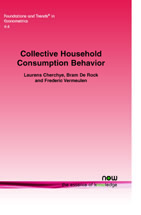Collective Household Consumption Behavior: Revealed Preference Analysis
By Laurens Cherchye, Center for Economic Studies, University of Leuven, Belgium, laurens.cherchye@kuleuven-kortrijk.be | Bram De Rock, ECARES, Université Libre de Bruxelles, Belgium, bderock@ulb.ac.be | Frederic Vermeulen, Netspar, CentER, Tilburg University, The Netherlands, frederic.vermeulen@uvt.nl
Abstract
We review a nonparametric "revealed preference" methodology for analyzing collective consumption behavior in practical applications. The methodology allows for accounting for externalities, public consumption, and the use of assignable quantity information in the consumption analysis. This provides a framework for empirically assessing welfare-related questions that are specific to the collective model of household consumption. As a first step, we discuss the testable necessary and sufficient conditions for data consistency with special cases of the collective model (e.g., the case with all goods publicly consumed, and the case with all goods privately consumed without externalities); these conditions can be checked by means of mixed integer (linear) programming (MIP) solution algorithms. Next, we focus on a testable necessary condition for the most general model in our setting (i.e., the case in which any good can be publicly consumed as well as privately consumed, possibly with externalities); again, this condition can be checked by means of MIP solution algorithms. Even though this general model imposes minimal structure a priori, we show that the MIP characterization allows for deriving bounds on the feasible income shares. Finally, we illustrate our methods by some empirical applications to data drawn from the Russian Longitudinal Monitoring Survey.
Collective Household Consumption Behavior
Collective Household Consumption Behavior: Revealed Preference Analysis presents a nonparametric 'revealed preference' methodology for analyzing collective consumption behavior in practical applications, while possibly accounting for externalities, public consumption and the use of assignable quantity information.
Collective Household Consumption Behavior: Revealed Preference Analysis considers two types of collective models: The general collective model considers general preferences of the individual household members, which allow for externalities and public consumption within the household. The special collective models that do not allow for consumption externalities.
After the introduction, section 2 sets the stage by introducing the revealed preference characterizations of the unitary model. Section 3 presents a collective model that allows for general individual preferences and discusses its revealed preference characterization. Sections 4 and 5 show how to bring this theoretical characterization to observational data. More specifically, Section 4 introduces the mixed integer programming characterizations for special collective models that impose restrictions on the household members' preferences. Section 5 does the same for the general collective model. Throughout Section 2 to Section 5, the authors illustrate the most relevant concepts by means of numerical examples. In Section 6 we subsequently illustrate our main results for data drawn from the Russian Longitudinal Monitoring Survey.
